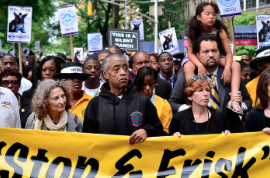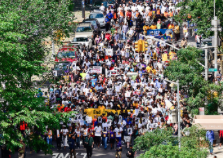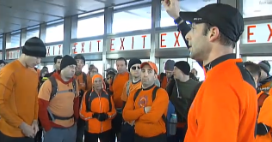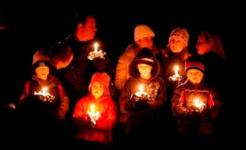 This year, communities across the country found themselves overwhelmed by a number of crises—incidents of hate and violence, but also brutal natural disasters—testing neighborhoods everywhere.
This year, communities across the country found themselves overwhelmed by a number of crises—incidents of hate and violence, but also brutal natural disasters—testing neighborhoods everywhere.
But we also witnessed those same communities rise up to help the bereaved and stand up for their neighbors in times of great distress. From the destruction of Hurricane Sandy to the unimaginable grief of the residents of Oak Creek, WI, people rose up to defend others from both intolerance and offer neighborly support.
As we ring in the New Year, we want to remember those who did their part to stand up to injustice and to lend a helping hand. Thank you for helping us stop hate, together.
Standing Up, Speaking Out
In January, we started the year with the debut of our five-part series on the different ways students from around the country were addressing bullying in their schools. With support from the Einhorn Family Charitable Trust, we produced five short films and lesson guides with our education partner, Facing History and Ourselves, to help teach students how to approach bullies both on and offline, and how to spread a message of inclusiveness to an entire school.
.png) In February, Not In Our Town: Class Actions premiered nationally on PBS. Class Actions profiled students and community members creating change in the face of lingering racist symbols at the University of Mississippi, anti-Semitic incidents at Indiana University, and the traumatic consequence of bullying in California.
In February, Not In Our Town: Class Actions premiered nationally on PBS. Class Actions profiled students and community members creating change in the face of lingering racist symbols at the University of Mississippi, anti-Semitic incidents at Indiana University, and the traumatic consequence of bullying in California.
In April, we profiled J. Ryan Leach, a University of Virginia student who had taken to forums on the Internet to take a stand against intolerant speech. For too long, Leach said he’d heard racist and bigoted comments. He wrote this column for NIOT to try to express why he felt so strongly about standing up to hate online.
In June, Marshalltown, IA launched its own Not In Our Town campaign to prevent bullying in its schools. "We want to see if we can be ahead of the curve as a community in preventing bullying," said Mike Schlesinger, publisher of the the central-Iowa based Times-Republican.
Later that month, New Yorkers marched to protest the city’s “stop-and-frisk” policy that opponents labeled as racist. The Silent March, one of many such demonstrations that have occurred throughout the history of the civil rights movement, was also organized to support Trayvon Martin, the black teenager shot by George Zimmerman.
Sandy Sparks Community Response In late October, Hurricane Sandy devastated New York and New Jersey. Thousands were left without power, food and homes. The destruction was enormous, second only to Hurricane Katrina in the total cost of the damage.
In late October, Hurricane Sandy devastated New York and New Jersey. Thousands were left without power, food and homes. The destruction was enormous, second only to Hurricane Katrina in the total cost of the damage.
With such a huge crisis on their hands, emergency responders were overwhelmed. And that’s where others started to step in. Neighbors helped neighbors. Marathon runners ran supplies for dozens of miles to get what little they could carry on their backs to those in need. Others donated what they could, including using innovative strategies to help others charge their much needed smart phones.
Mass Shootings Inspired Fear, But Responses Gave Reasons to Hope
This year gave the country few respites from the shock and sadness of several mass shootings. The attacks ranged widely in scope and media coverage. Some were racially motivated. No matter how unimaginable the tragedy, however, the communities that suffered from these shootings were committed to coming to together to help their fellow residents begin to heal.
In April, shootings in Tulsa, OK, left five people dead. The assailants had traveled to a predominantly African-American area of the city to find their victims. But the community response was immediate and forceful—tipsters responded to calls from the local police for evidence, directly leading to the arrest of the two perpetrators. Meanwhile, faith leaders in the area brought their flocks together for prayer and remembrance of the fallen.
In August, we again witnessed an incident of hate. In Oak Creek, WI, a white supremacist gunned down six members of the Sikh Temple of Wisconsin. But rather than give in to fear, the city responded by offering their full support for their Sikh neighbors. More than 100 vigils popped up around the country, sending messages of love and acceptance to the temple’s members. But the violence of these shootings seemed to be ever present this year. In July, just a few weeks before the Oak Creek shooting, 12 people were killed when a gunman ambushed moviegoers in an Aurora, CO theater. Worse still, 26 teachers and students were killed in another shooting rampage in Newtown, CT, just two weeks before Christmas. Vigils and memorials for the victims were widespread.
But the violence of these shootings seemed to be ever present this year. In July, just a few weeks before the Oak Creek shooting, 12 people were killed when a gunman ambushed moviegoers in an Aurora, CO theater. Worse still, 26 teachers and students were killed in another shooting rampage in Newtown, CT, just two weeks before Christmas. Vigils and memorials for the victims were widespread.
The Westboro Baptist Church attempted to spread its message of hate when it announced it would protest at the funerals of those children killed in Newtown. But many communities, online and off, showed that they had had enough of the WBC. One Facebook group, Counter Action Against WBC Picketing Newtown Shooting Victims, comprised of more than 7,500 members, organized a “human wall of love.”
On Friday, Dec. 21, bells rang across the country to remember those lost in Newtown. Bells were rung at the National Cathedral in Washington and the Cathedral of Saint Mary in Miami. Traders at the New York Stock Exchange paused silently for one minute before the opening bell.
Thirty states participated in a moment of silence that morning to honor the victims. The states honoring a moment of silence were Alaska, California, Colorado, Delaware, Florida, Hawaii, Idaho, Illinois, Iowa, Kansas, Kentucky, Massachusetts, Michigan, Missouri, Nebraska, Nevada, New Jersey, New Mexico, North Carolina, Oregon, Pennsylvania, Rhode Island, South Carolina, Texas, Vermont, Virginia, West Virginia, Wisconsin and Wyoming. President Obama ordered the flags to fly at half-mast.
“For those of us who remain, let us find the strength to carry on and make our country worthy of their memory,” Obama said at a vigil in Newtown.
Support Not In Our Town in 2013. Sign up for our newsletter or make a donation.
Add new comment